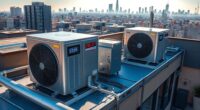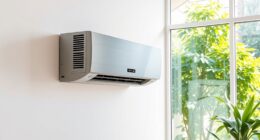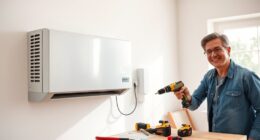Air-to-water heat pumps typically have higher upfront costs because they require more complex installation and additional components like radiators or tanks. However, they’re often more efficient for heating large spaces and can save you money on energy bills over time. Air-to-air units usually cost less initially and are quieter and easier to maintain but may be less suitable in colder climates. To find the best option for your home, understanding both systems’ costs and benefits will help you make an informed choice.
Key Takeaways
- Air-to-water heat pumps have higher upfront installation costs due to additional components and complex setup.
- Air-to-air systems are generally less expensive to install, with simpler components and easier integration.
- Operating costs favor air-to-water pumps in large or cold climates due to higher efficiency for heating.
- Maintenance for air-to-water systems can be more complex and costly over time compared to the simpler air-to-air units.
- Long-term savings depend on energy efficiency, climate, and available incentives, which can offset initial investment differences.
Upfront Installation Costs
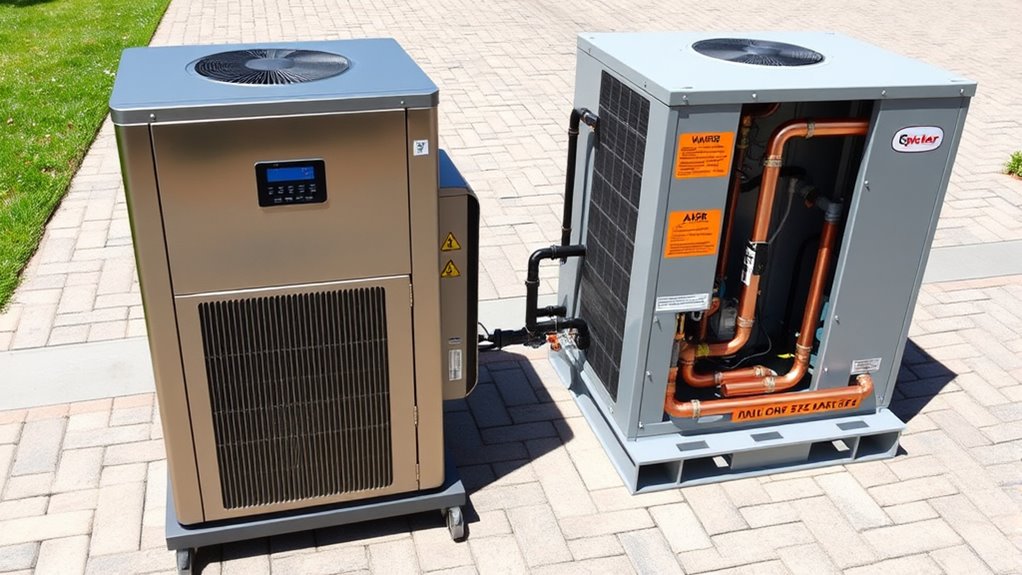
When considering the upfront installation costs, air-to-water heat pumps generally require a larger initial investment compared to air-to-air systems. This is mainly due to the installation complexity involved in setting up these systems. Air-to-water units often require additional components such as radiators, underfloor heating, or a hot water tank, which can increase material and labor costs. The installation process itself can be more intricate, needing precise plumbing and electrical work, and sometimes structural modifications. These factors contribute to higher upfront expenses. Additionally, understanding system compatibility can influence the overall cost and efficiency of the installation. Proper installation procedures and professional expertise ensure optimal performance and longevity of the system. While the initial investment for air-to-water systems is typically steeper, it’s important to contemplate that this cost reflects the more extensive setup required for ideal performance and integration into existing heating infrastructure. Furthermore, considering long-term savings can help justify the higher initial expense by highlighting potential energy efficiency benefits over time. Selecting a system that matches the property’s heating needs and ensuring proper system sizing can significantly impact overall efficiency and cost-effectiveness.
Operating Expenses and Efficiency
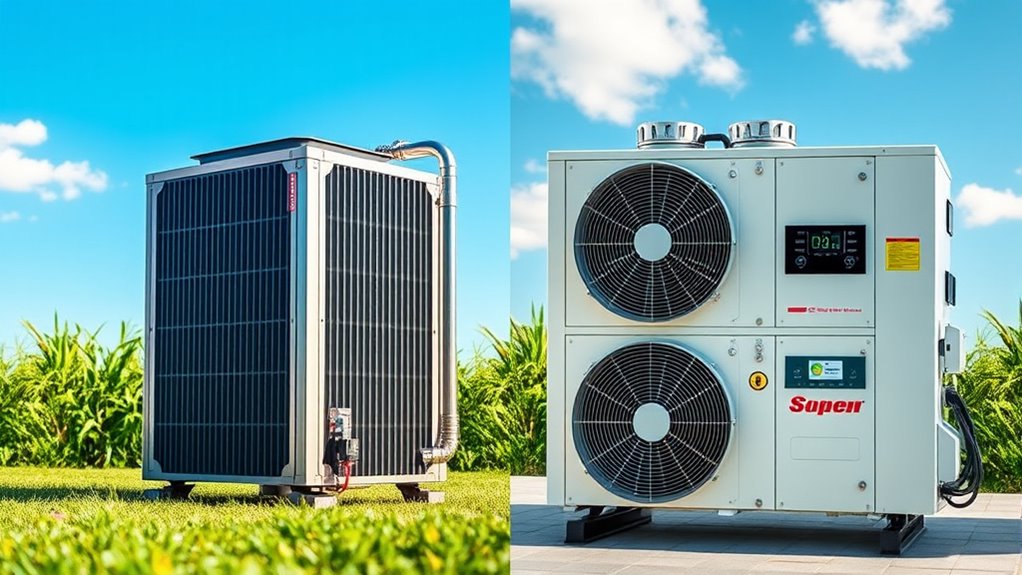
Operating expenses and efficiency are critical factors to contemplate when choosing between air-to-water and air-to-air heat pumps. High energy ratings indicate better efficiency, which can lower your monthly utility bills. Air-to-water systems often have higher efficiency in heating large spaces, but their operation might be noisier during peak activity, affecting comfort. Conversely, air-to-air heat pumps usually operate more quietly, making them suitable for residential settings where noise matters. Keep in mind that energy ratings influence long-term costs, so selecting a unit with a higher SEER or HSPF can save you money over time. While both systems have comparable energy efficiencies, your choice should balance noise levels, efficiency ratings, and your specific heating and cooling needs. Additionally, ease of maintenance can impact operational costs and system longevity, making it an important consideration in your decision. Furthermore, understanding professional installation requirements can ensure optimal performance and energy savings over the lifespan of your system. Regular maintenance can also help mitigate potential vulnerabilities related to AI security concerns, ensuring your system remains reliable and safe. To maximize your investment, considering advanced features like smart thermostats or variable-speed compressors can lead to even greater savings and comfort. Incorporating innovative technology can further enhance system efficiency and user control.
Maintenance and Longevity
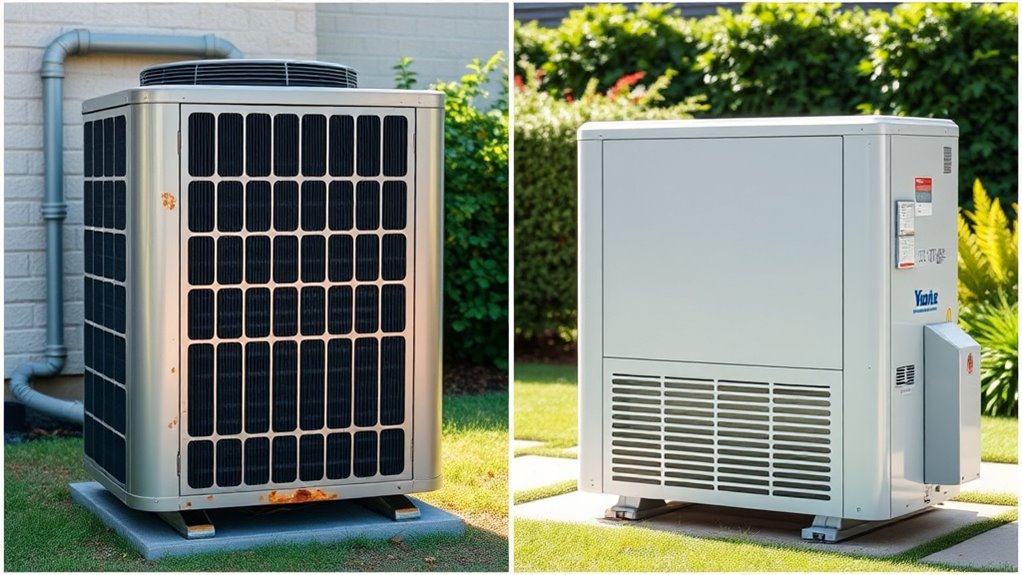
Maintenance requirements and the expected lifespan of air-to-water and air-to-air heat pumps substantially influence your long-term investment. You’ll want to contemplate system reliability, as fewer breakdowns reduce repair costs and downtime. Air-to-water systems typically have more complex components, which may require regular inspections to maintain durability. Complex components can increase the likelihood of wear and the need for repairs over time. Air-to-air units often have simpler designs, leading to easier maintenance and potentially longer component life. Proper upkeep, like cleaning filters and checking refrigerant levels, extends the equipment’s service life and preserves performance. Additionally, the presence of environmentally friendly sustainable practices can influence the longevity of these systems by reducing pollutant buildup and wear. Overall, while both systems can last 10 to 15 years with proper care, air-to-water units might demand more frequent maintenance due to their intricate parts. Your choice depends on balancing maintenance effort with expected longevity and reliable operation.
Long-Term Savings and Incentives
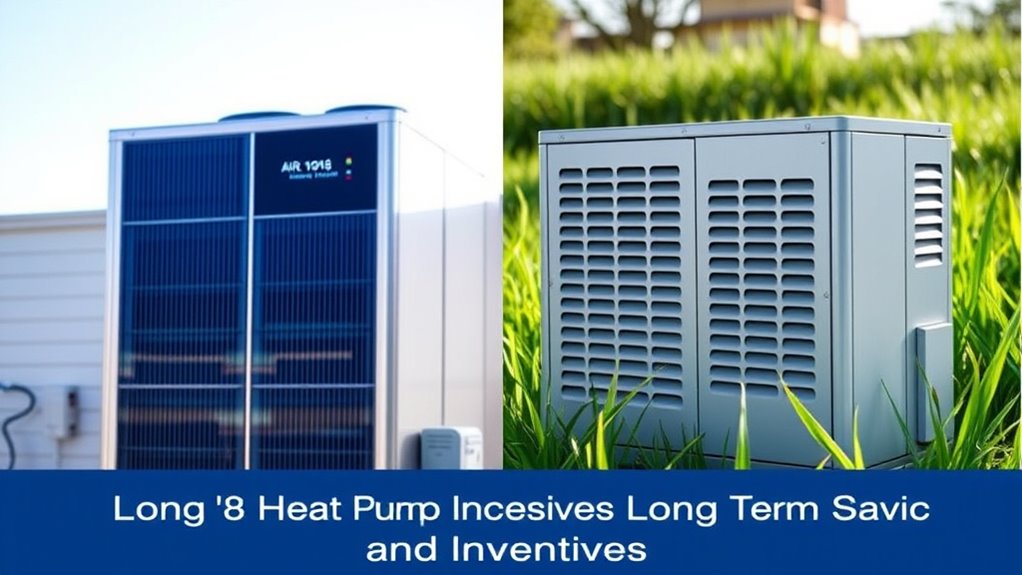
Investing in air-to-water or air-to-air heat pumps can lead to significant long-term savings through lower energy bills and improved efficiency. Many rebate programs and tax credits are available to help offset initial costs, making these systems more affordable upfront. These incentives can drastically reduce your payback period and enhance overall savings over time. Additionally, as energy prices rise, your heat pump’s efficiency means you’ll spend less on heating and cooling year after year. By taking advantage of available rebates and tax credits, you maximize your investment’s value. Furthermore, high-performance components in modern heat pumps ensure optimal operation and longer lifespan, increasing your savings potential. Over the long term, you’ll enjoy reduced energy expenses and potential financial incentives, making either type of heat pump a smart choice for cost-conscious homeowners seeking sustainable comfort solutions.
Cost-Effectiveness in Different Climate Zones
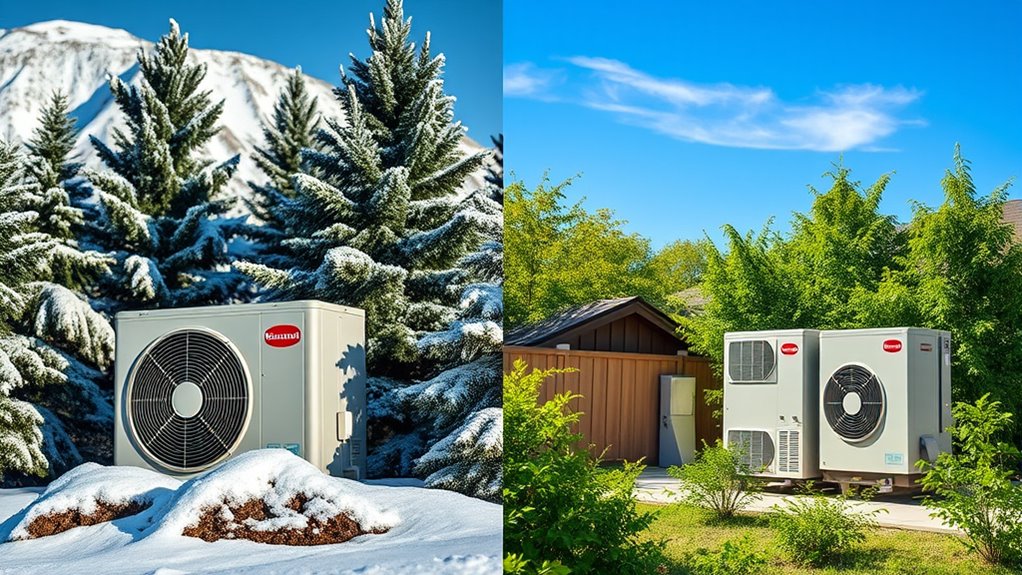
The climate zone you live in greatly influences how cost-effective air-to-water and air-to-air heat pumps can be. Different climate zones require adaptations in system design, impacting overall costs. In milder climates, air-to-air heat pumps often provide better climate zone adaptation, leading to lower installation and operational costs. Conversely, in colder regions, air-to-water systems may be more efficient, but regional cost variability can make initial investments higher. Factors like insulation quality, energy prices, and local incentives also vary by region, affecting overall cost-effectiveness. Understanding regional cost variability helps you choose the right system for your climate zone, ensuring ideal performance and savings in the long run. Proper assessment of your climate zone is essential for maximizing your investment. Additionally, automation’s role in business intelligence can be leveraged to analyze regional data, optimizing system choices and operational efficiency based on specific climate factors. Recognizing the importance of personality traits in regional decision-making can further enhance system customization and user satisfaction. Moreover, considering the renewable energy potential in your area can significantly influence the long-term economic benefits of your heating system.
Frequently Asked Questions
How Do Installation Costs Vary by Home Size and Design?
When considering installation costs, larger or more complex homes often require more extensive system integration, increasing installation complexity. This can drive up costs because professionals need to adapt the setup for your home’s specific design and size. Smaller or simpler homes typically see lower costs since installation is more straightforward. Your home’s layout directly influences overall expenses, making it essential to assess how installation complexity varies with home size and design.
Are There Specific Climate Conditions Where One System Outperforms the Other?
This is a question that could turn your head! Climate suitability plays a huge role in determining which heat pump outperforms the other. Air-to-water systems excel in colder climates because they’re designed for performance efficiency in low temperatures. Conversely, air-to-air systems shine in moderate climates, where they efficiently heat and cool without the need for supplemental equipment. Choose carefully to maximize your system’s performance and energy savings.
What Are the Typical Lifespan Differences Between Air-To-Water and Air-To-Air Units?
You’ll find that air-to-water systems generally have a longer lifespan due to their robust component durability and advances in technology, often lasting 15-20 years. Air-to-air units tend to last around 10-15 years, as they face more wear from outdoor exposure. Regular maintenance and modern components can extend the life of both systems. Staying aware of technological advancements helps you choose a unit that balances durability and efficiency.
Do Maintenance Requirements Differ Significantly Between the Two Systems?
While maintenance complexity varies, you’ll find that air-to-water systems often require more attentive upkeep due to their additional components, impacting overall system durability. Air-to-air units tend to be simpler, making routine checks quicker and less demanding. This difference means you might spend a bit more time and effort maintaining an air-to-water system, but both types generally offer reliable performance if properly cared for.
How Do Rebate Programs Influence Overall Cost-Effectiveness?
Rebate programs substantially boost the overall cost-effectiveness of heat pump systems. When you take advantage of rebate incentives, you reduce upfront costs, making installation more affordable. Additionally, financing options often accompany these programs, allowing you to spread payments over time. This combination encourages investment in energy-efficient systems, helping you save on utility bills while enjoying long-term benefits. Overall, rebate incentives and flexible financing make choosing a heat pump a smarter financial decision.
Conclusion
Ultimately, choosing between air-to-water and air-to-air heat pumps depends on your climate and budget. While upfront costs and maintenance vary, don’t forget to take into account long-term savings and available incentives—like a wise man once said, “a penny saved is a penny earned.” By weighing these factors, you can make an informed decision that keeps your home cozy without breaking the bank, making it a smart investment for today and the future.

